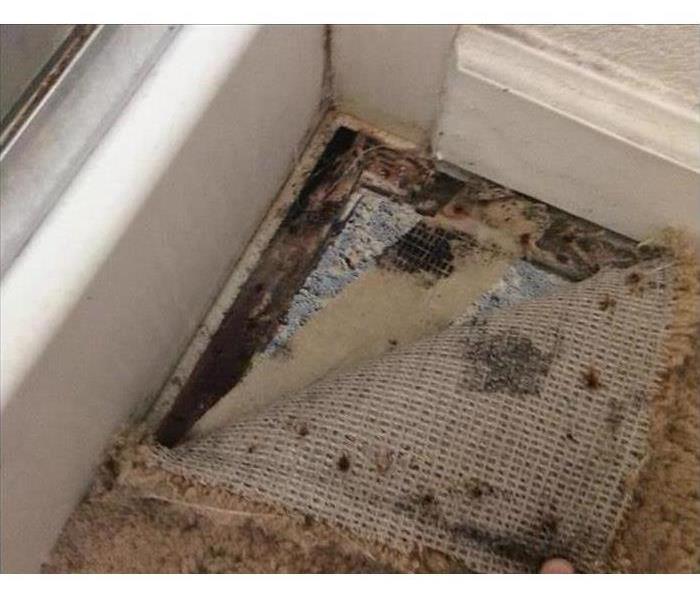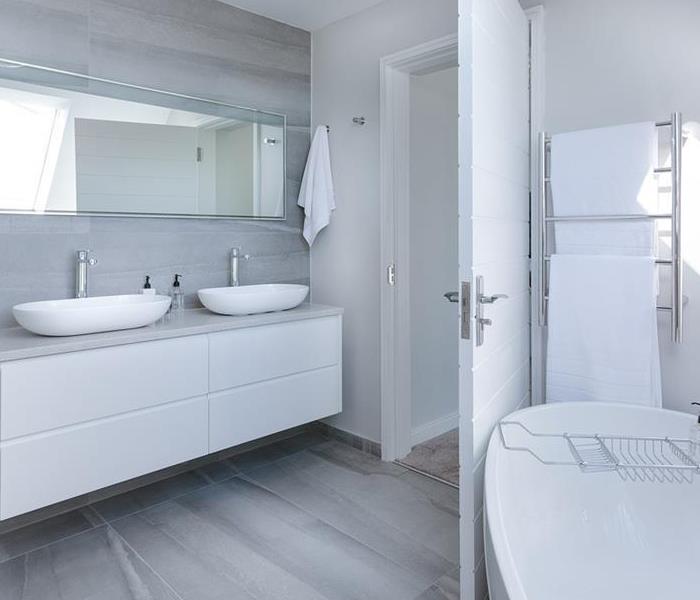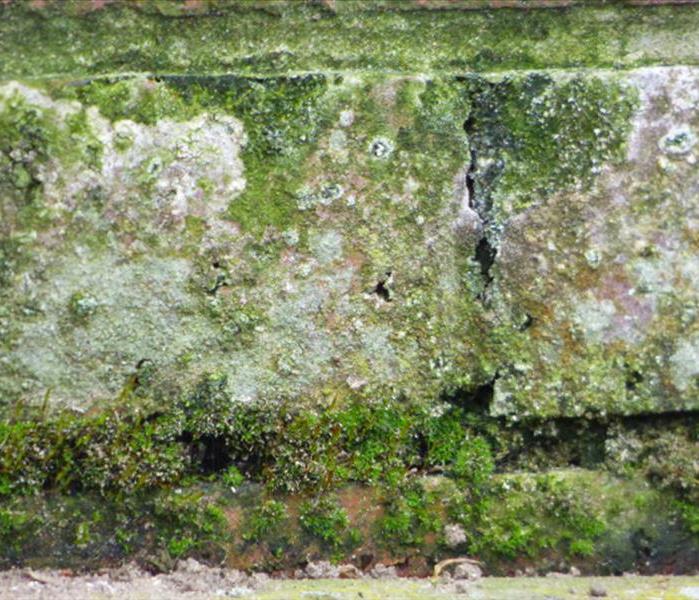Recent Mold Remediation Posts
Removing Mold From a Carpet
1/20/2019 (Permalink)
 Mold remediation is a tough job, so act fast if you spot mold on a carpet.
Mold remediation is a tough job, so act fast if you spot mold on a carpet.
A damp carpet—whether from a leak, a spill or your favorite pet—can create mold growth in a matter of days, putting you at risk of health complications. If the affected spot is less than 5 feet in width, you may want to tackle it yourself, but anything larger will require treatment by professionals like SERVPRO of Manchester/Mansfield, because the mold has likely spread to the underlay or flooring.
Either way, mold spreads rapidly, so act fast! An anti-fungal spray designed to kill mold, available in retail stores and home centers, is a better option than bleach, which can discolor carpet. Tools you’ll need include a facemask and eye protection, rubber gloves, a stiff bristle brush, dustpan and trashbag, rags, an antifungal spray and a dehumidifier.
Step 1
Put on a facemask, eye protection and rubber gloves before you start. Ventilate the space by opening windows or, if possible, remove the rug and take it outside. If you can’t remove or lift the carpet, treat the visible surface mold.
For professional mold remediation services, call SERVPRO of Manchester/Mansfield today at 860.649.0836
Step 2
If possible, lift the carpet until you reach the affected area and examine the backing. Backing with substantial mold growth of more than a few feet in width needs to be replaced. Either throw out the carpet or cut off the mold-covered area plus a 12-inch margin and insert new carpet. Remove and replace the portion of underlay or carpet pad, too.
Step 3
Scrub the surface of the carpet with a dry, stiff bristle brush to remove the visible mold spores. Brush these into a dustpan and discard in a trash bag. (Do not vacuum—that will spread spores to other areas of your home.) Scrub the back of the rug as well, if you can reach it.
Step 4
Thoroughly saturate the moldy area and a 6-inch margin with anti-fungal spray (must be safe for carpets and have a “mold barrier” or mold prevention). Cover both the front and back, if possible, and the area of the floor beneath the moldy portion. Let the anti-fungal spray sit for one hour, then blot with a clean, dry rag.
Step 5
Let the carpet dry completely, which will take at least 24 hours. You may improve drying by closing your windows, turning up the heat in the room, and running a dehumidifier. Do not use a fan, as that will spread the mold spores, and don’t walk on the area or allow pets near it while it’s drying.
Step 6
Clean the bristle brush and dustpan by scrubbing with hot soapy water, then spraying with anti-fungal treatment and allowing it to dry completely. Bag and throw out the rag and rubber gloves.
For professional mold remediation services, call SERVPRO of Manchester/Mansfield today at 860.649.0836
Step 7
Once the carpet has dried thoroughly, repeat Steps 4, 5 and 6, using a clean rag to blot (discard after blotting). Once the carpet has dried a second time, run the dehumidifier for a few more days to remove mold spores from the air.
After the carpeting has dried fully, you should be mold-free, but check the spot every day or so for a month to make sure that mold hasn’t returned.
We’re Here to Help
When you don’t want to tackle the tough job of mold remediation, call a professional with a solid record of serving the Connecticut region: SERVPRO of Manchester/Mansfield at 860.649.0836, around the clock. At SERVPRO, we know the safest, quickest and most effective ways to help you remove mold contamination for good and reduce the mold in your commercial or residential property.
Other Helpful Blog Posts
Every month on the SERVPRO of Manchester/Mansfield blog we publish educational articles on how Manchester and Mansfield residents can protect their homes and businesses from disasters and how to deal with mold, fire, water, sewage, storm and other damage. Here are a few blog posts that you might find helpful:
We’re Here for You
SERVPRO of Manchester/Mansfield
We serve Amston, Andover, Bolton, Columbia, Coventry, Hebron, Manchester, Mansfield and Storrs, Connecticut.
53 Slater Street, Unit 2, Manchester, CT 06042
IICRC Certified
Ralph DiCristofaro
Certified SERVPRO technicians
Call 860.649.0836
24-hour emergency service
For professional mold remediation services, call SERVPRO of Manchester/Mansfield today at 860.649.0836
5 Ways To Prevent Mold
8/27/2018 (Permalink)
 To stop mold growth, pay special attention to your bathroom
To stop mold growth, pay special attention to your bathroom
Mold isn’t always bad. Did you know mold is essential in making brie and penicillin? Mold also is required for the decomposition of organic matter in nature. But mold in your house? That’s a whole different story, especially when you realize it often grows undetected in your home.
Mold spores love to spread and they do so easily. No matter how great you clean you cannot get rid of all mold. Adding to the problem is that mold can grow anywhere--carpet, clothing, food, paper, and in places you can't see like the backside of drywall, areas inside walls around leaking or condensing pipes, and above your home’s ceiling tiles.
So, what can you do to prevent mold from growing in your house? The Mother Nature Network has some good tips. Here are five actions that will help.
1. Identify problem areas in your home and correct them.
You can't mold-proof your home, but you can make your house mold-resistant. Do a moisture audit of your home. Where do things get wet? Does your home’s basement flood? Is there a water stain on the ceiling from a persistent leak? Do you have frequent condensation on an upstairs window?
Preventing mold from growing or spreading might be as simple as ripping up carpet in a damp basement, installing mold-resistant products, or repairing damaged gutters. Or it may be a matter of major excavation and waterproofing. Whatever the case, address the problem now. It might cost some money up front, but it will surely be more costly down the road if mold continues to grow unchecked.
2. Dry wet areas immediately.
Mold can't grow without moisture. Wherever you see water or moisture take care of it right away. Clean up that seepage into the basement after a heavy rainfall. Stop the moisture of the leaky pipe. Dry up the spill on the carpet within 24 hours or less. After a flood you definitely need to be sure to thoroughly dry everything affected by the flood waters.
Everyday occurrences need attention, too. Don't leave wet items lying around the house. Dry the floor and walls after you take a shower. Remove wet clothes from the washing machine immediately and hang them to dry. Dry your clothes outside or in an area that features good air flow.
Questions about mold or mildew? We are experts. Call SERVPRO of Manchester/Mansfield at 860.649.0836
3. Clean with all the right tools.
No matter how successful you are at preventing mildew and mold from growing you will still have some. To clean mold in the fastest and most effective way make sure you have latex or rubber gloves, buckets and brushes, a vacuum with brush attachment, a mop and sponges, nonammonia detergent, soap, or a commercial cleaner, disinfectant chlorine bleach, and furniture polish. You won’t need all of these tools all of the time but they will all come in handy sometime.
4. Give your bathroom special attention.
Few rooms in your home see as much moisture and humidity as your bathroom. Be sure your bathroom stays well-ventilated. Use an exhaust fan to help circulate the air and remove moisture more quickly. Spread your towels out after use so they dry more quickly. Don’t keep many containers in the shower (cleaning is then easier and the air circulates better). Wipe down the shower with a clean towel or squeegee after its last daily use. Choose shower curtains that dry and clean easily to help avoid soap residue, which fosters mold.
If mildew does accumulate on your shower curtain wash it in a solution of 1/2 cup liquid disinfectant to 1 gallon of hot water. Rinse with a mixture of one cup lemon juice and one cup salt to a gallon of hot water. Wash with detergent and bleach (using color-safe bleach on color fabrics). Rinse the shower curtain in clear water.
Questions about mold or mildew? We are experts. Call SERVPRO of Manchester/Mansfield at 860.649.0836
5. Prevent moisture with proper ventilation.
Sometimes daily activities encourage the growth of mold in your home. Be sure that the way you cook dinner, take a shower, or do a load of laundry doesn't invite mold to grow. Provide proper ventilation in your bathroom, kitchen, laundry room, and other high-moisture areas. Vent appliances that produce moisture (clothes dryers, stoves) to the outside (not the attic). Use air conditioners and dehumidifiers, especially if you live in a humid climate. Make sure your AC units and dehumidifiers don’t produce moisture themselves by checking them and cleaning them as directed by the manufacturer. If your home is energy-efficient it may hold in moisture. If so open a window when cooking or washing dishes or showering, or run an exhaust fan.
More Information On This Blog
You can learn more by reading other posts on this SERVPRO of Manchester/Mansfield blog:
Contact Us Anytime
In Manchester the team at SERVPRO has specialized training and experience in water damage restoration services, fire damage restoration services, mold remediation, commercial services, and natural disaster cleanup. Call SERVPRO of Manchester/Mansfield anytime at 860.649.0836.
SERVPRO of Manchester/Mansfield
IICRC Certified
Ralph DiCristofaro
540 N. Main Street
Manchester, CT 06042
Call 860.649.0836
24-hour emergency service
Don't Kill Mold With Bleach
6/7/2018 (Permalink)
 Bleach isn't the best long-term solution for fighting mold.
Bleach isn't the best long-term solution for fighting mold.
When most people see mold they think of treating it with bleach. To an untrained professional, cleaning mold with bleach can seem right. But here are three reasons why bleach is not the most effective choice to rid your home or business of mold.
1. Bleach loses effectiveness over time.
Chlorine bleach rapidly loses its effectiveness. Try leaving a glass of chlorinated water out on the counter for a few days. You’ll find the chlorine will evaporate. This happens within bleach containers as well. Evaporation means that it will be hard to determine the true potency of your chlorine bleach solution because the chlorine can escape through plastic. Perhaps the chlorine bleach you’re using has been sitting at the store, or in your home for months or longer. That will lessen its power to kill mold.
For Mold, Fire & Water Cleanup & Restoration Call SERVPRO of Manchester/Mansfield At (860) 649-0836
2. Bleach does not kill mold on porous surfaces. In fact, bleach can contribute to mold growth.
Yes, chlorine bleach can kill surface mold. But mold can grow deep roots within porous surfaces like wood and drywall. Those roots will not be affected by bleach. The bleach you apply remains on the surface while the water in the bleach goes deeper and can feed the mold growth.
And not only does mold have roots, mold also releases spores. These mold spores can get into the air and land anywhere. Once spores travel and land elsewhere, if the environment is right, more mold will grow. Chlorine bleach cannot stop mold from spreading in this way.
For Mold, Fire & Water Cleanup & Restoration Call SERVPRO of Manchester/Mansfield At (860) 649-0836
3. Bleach is toxic.
Chlorine bleach produces fumes that pollute the air and can become harmful to humans and pets. Chlorine bleach also generates a by-product called dioxin, which is linked to cancer. If you use bleach over time you can build up these pollutants in your home, business, or any environment.
So, you can use bleach to temporarily kill what’s on the surface but treating mold with bleach alone is not effective in the long run. You won’t know how potent the bleach you use is and using bleach means exposing yourself to harmful fumes.
Get Rid of Mold Issues for Good
Specialists in professional remediation can be your best bet when it comes to getting rid of mold effectively. Our crews at SERVPRO of Manchester/Mansfield use special cleaners and equipment to get rid of mold, including spores. We can identify the full extend of your mold infestation and treat mold-infested areas safely and effectively.
More Information
SERVPRO of Manchester/Mansfield publishes educational articles on how Manchester area residents and businesses can protect themselves from mold and natural disasters and restore their property after a flood, sewage spill or other harmful event. We also try to give you ideas about resources in the greater Manchester and Mansfield community. Here are a few blog posts you might find helpful:
Contact Us Anytime
In Manchester, the team at SERVPRO has specialized training and experience in water damage restoration services, fire damage restoration services, mold remediation, commercial services, and natural disaster cleanup. Call SERVPRO of Manchester/Mansfield anytime at 860.649.0836.
SERVPRO of Manchester/Mansfield
IICRC Certified
Ralph DiCristofaro
540 N. Main Street
Manchester, CT 06042
Call 860.649.0836
24-hour emergency service






 24/7 Emergency Service
24/7 Emergency Service

